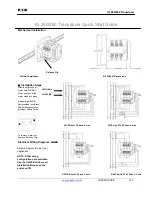
4
A-96.250.331 / 230320
AMU Powercon
Product Description
Alarm Relay
One potential free contact. Summary alarm indication for program
-
mable alarm values and Instrument faults.
Available in two configurations:
Normally open*: Closed during normal operation, open in case of
error or power loss.
Normally closed: Open during normal operation, closed in case
of error or power loss
*Standard configuration. To order the version with normally closed
alarm relay, contact your dealer in advance.
Maximum load: 100 mA/50 V
Input
One input for potential-free contact to freeze the measuring value
or to interrupt control in automated installations. Programmable as
HOLD or OFF function
.
Communica
-
tion interface
RS232 for logger download with HyperTerminal
RS485 with Fieldbus protocol Modbus or Profibus DP (optional)
Safety
Features
No data loss after power failure. All data is saved in non-volatile
memory.
Over voltage protection of in- and outputs.
Galvanic separation of measuring inputs and signal outputs.
M
easuring
principle
When a voltage is set between two electrodes in an electrolyte
solution, the result is an electric field which exerts force on the
charged ions: the positively charged cations move towards the neg
-
ative electrode (cathode) and the negatively charged anions to
-
wards the positive electrode (anode). The ions, by way of capture
or release of electrons at the electrodes, are discharged and so a
current
I
flows through this cycle and the Ohms law
V = I×R
ap
-
plies. From the total resistance
R
of the current loop, only the resis
-
tance of the electrolyte solution, respectively its conductivity
1
/
R
, is
of interest.
The cell constant of the sensor is determined by the manufacturer
and is printed on the sensor label. If the cell constant has been pro
-
grammed in the transmitter, the instrument measures correctly.
Measuring unit is
S/cm or
S/m.
Specific
Conductivity
Conductivity from all ions in the sample, mainly the alkalization
agent. The contribution of impurities is masked by the alkalization
agent.
Cation Con
-
ductivity (Acid
Conductivity):
The alkalization agent is removed in the cation column. All cationic
ions are exchanged with H+, all anionic impurities (ions with nega
-
tive charge) pass through the column unchanged.











































